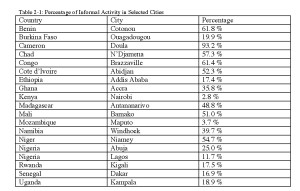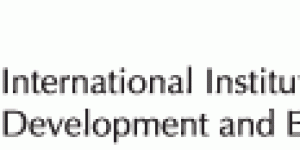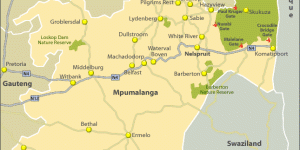IIDE Proceedings 2014 – The Informal Sector And Local Economic Developments In South Africa: An Evaluation Of Some Critical Factors
No comments yetThe importance of achieving the goals of a better life for all highlights a critical need to expand our economic development policy levers. Accordingly, the objective in this paper is to examine the critical link between informal sector and the challenges of development in South Africa. Given the heterogeneous nature of the sector, policy instruments aimed at developing the sector cannot be one size fits all. Finally, this paper reveals a number of concerns which can be addressed in future research including policy guidance and methodologies that can be used to incorporate gender into the overall planning of local economies.
1. Introduction
South Africa continues to face key development challenges of poverty, unemployment and inequality. Given the importance of achieving the goals of a better life for all South African citizens, there is a need to explore development alternatives which can lead to a more inclusive form of economic development and economic growth. More specifically, one of the economic sectors that has often been overlooked in economic policy analyses is the informal sector. The increased focus on informal sector is based on the observation that it employs a large number of people and therefore can contribute to poverty reduction. Again, the increased interest in the informal sector is partly driven by an observed increase in the size of the sector. For example, statistics highlight that between 1997 and 2005, about 1.1 million jobs were created in the informal sector (Altman, 2007). Typically, in 2007 it was estimated that there were 3,65 million people in non-agricultural informal employment in South Africa (Wills, 2009). Within the informal sector, street vending remains a dominant form of economic activity. It makes up 15 percent of non-agricultural informal employment, with over 500 000 street vendors in informal employment of whom about 360 000 were women (Wills, 2009). Consequently, the informal sector can be recognised for its role particularly in addressing the development challenges of poverty and unemployment. However, what needs to be recognised is that the informal sector remains largely neglected within the conventional policy making processes. Indeed, an improved understanding of the nature, workings and potential contribution of the informal sector is critical if we want to ensure a more inclusive form of economic development.
The objective in this paper is to examine the link between informal sector and the challenges of development in South Africa. Likewise, the contention in this paper is that improving the performance of informal sector may contribute to a more inclusive form of economic development. Therefore, the emphasis in this paper is to highlight the importance of expanding opportunities for those that continue to be marginalised within the national economic policy development. Overall, the efforts to improve the performance of informal sector should be seen in light of the potential contribution of the sector in increasing the overall performance of the national economy.
This paper is based on the examination of available material in the form of both published and unpublished sources. In analysing the issues affecting the informal sector, this paper acknowledges that the informal economy cannot be viewed purely in economic terms. Accordingly, the analysis of informal economy in this paper includes history, political, social and economic issues. More importantly, this analysis recognises the interplay between politics and economy as these factors can enhance or constrain development. In terms of its conceptual framework, the paper is located within the systems of innovation which recognises informal sector as an equally important area of economic policy development. Finally, this paper is organised into four strands of material. The first section examines the importance of incorporating informal sector into the overall planning of local economic development (LED). The second section explores the notion of including the informal sector in the national plans that seek to address skills and human resource development. The third strand of material incorporates a gender perspective in the analysis of informal sector. The last section highlights key conclusions which are derived from the analysis of issues in this paper.
2. The Importance of Incorporating Informal Sector in Local Economic Development Planning
The analysis in this section contends that the informal sector remains an important actor in the national systems of innovation and can be a critical instrument of local economic development in South Africa. However, it is worth noting that in the past, local governments in South Africa did not play a significant role in local economic development. They mainly existed as administrative instruments of government. Nevertheless, since 1994 there has been a remarkable transformation in local governance from one which focused primarily on the local provision of services and facilities, to one which stresses the deployment of resources and their mobilization to promote local economic development (Rogerson, 1996). This transformation has been accompanied by other transformational processes, such as globalization, decentralization and democratization of local government. These processes have increased the importance of local governments in economic development. Indeed, local governments are increasingly performing a pivotal role in tackling economic and social problems and in managing processes of economic transformation. Likewise, in many areas of South Africa, local economic development is increasingly linked to economic regeneration especially in the context of economic crises evident in many local economies. For example, the crises in mining have added pressure to already struggling local economies. Typically, this discussion highlights that the path to a more successful LED requires specialized capacity in the form of unique competencies on the part of local governments. Indeed, this specialized capacity can contribute to finding a balance between the objectives and a pro-growth and pro-poor local economic development.
Economic development planning has not been inclusive. Therefore, the need for a more inclusive form of economic development highlights the importance of incorporating the informal sector into the overall planning of local economies. This can ensure that the informal sector becomes a critical actor and beneficiary of a growing national economy. Again, this is particularly important to local economic development particularly due to the employment and income opportunities that are generated through the informal sector. What can be recognized is that the incorporation of informal sector into the broader national economic planning is part of an emerging thinking about development alternatives which seek to expand the number of actors in the national economy.
Since local government is not directly responsible for creating jobs, it can take active steps to ensure that the overall economic and social conditions within the locality are conducive to the creation of employment opportunities (South Africa, 2006). The promotion of legal measures that recognises the informal sector as a critical actor in local economic development will serve to commit local governments to support and facilitate an enabling environment in which informal sector participants can earn a living. More specifically, South African Local Government Association (SALGA) encourages municipalities to be more innovative and to view informal economy as part of local governments’ strategies to address unemployment, support livelihood creation, and reduce vulnerability. Consequently, this emerging thinking encourages municipalities to view informal sector development as a key service delivery function. In this emerging context, municipalities need to balance their regulatory function of the informal sector with the need to support livelihoods and employment creation in ways that reflect the agenda of a developmental state (SALGA, 2012).
Informal sector is increasingly being recognised for its contribution local development particularly poverty reduction and employment creation (eThekwini Unicity Municipality, 2001). Focusing on the informal sector is increasingly becoming a crucial element in the success of local economic development (LED) strategies. Indeed, LED provides a major opportunity for localities to improve the local economic growth and the performance of the informal sector. Typically, LED strategies and assessments of local economies should also incorporate the needs of the informal sector. Indeed, it is at the local level that the specific constraints affecting specific activities of informal sector can be better understood and effectively addressed. Bottlenecks facing the performance of the sector can be identified and addressed in order to improve its ability to contribute to improved local productive systems which can generate more employment opportunities. Indeed, the informal sector is glaringly visible throughout the Sub-Saharan Africa. It includes home businesses, domestic workers, street vendors, small-scale artisans, shoe shiners, car repairs, bakeries, and livestock traders and the sector makes a huge contribution to the local economies of Sub-Saharan African countries. Likewise, Table 2-1 reveals that in Africa informal work is often a dominant economic activity alongside the formal economy (Hobson, 2011). This observation is particularly important where neither the public sector nor the private sector is able to provide enough jobs for the expanding labour force.
In sum, it is becoming more clearer than before that self-employment particularly in the informal sector is increasingly becoming a recognised alternative to growing unemployment, particularly among the youth and the poor (Hobson, 2011). Indeed, the contribution of informal sector to LED will become more glaring as local governments push harder to address poverty, unemployment, and inequality. These local government efforts need to be accompanied by specific policy measures such as skills development.
3. Human Resources and Skills Development
The informal sector especially in Africa tends to be characterised by low levels of education amongst the owners and operators of informal enterprises. This situation tends to impact negatively on the training potential of these participants. Therefore, the efforts to strengthen the skills base of informal sector entrepreneurs can be an important intervention in the development of the informal economy. That is to say, the development of human resources in the sector should be viewed as an attempt to help those who are struggling to create productive employment (Grierson, 1997) and as part of broad national skills development policies.
Training can be used to increase the share of new start-up enterprises in economic activities that can yield higher returns rather than simply flooding product lines with activities that may already have large numbers of participants selling in saturated markets (Liedholm and Mead, 1999). That is to say, there is a need to highlight the importance of using skills development to expand economic opportunities for those that continue to be marginalised in the national economy. Indeed, these efforts should also be seen as part of initiatives that seek to increase the overall performance of the national economy and build a more inclusive and coherent skills development system. in this context, skills development in the informal sector can be used to improve the productivity of informal enterprises.
An important initiative relates to increasing access to vocational training especially for those who work in the informal sector. The vocational training colleges can provide a theoretical content and advanced production techniques for those who are already practically engaged on the job in order to improve their knowledge and learning capacity. This intervention can lead to more improvements in the sector as a whole. At the same time, this can contribute to improving the value and quality of the goods and services that can yield higher profits for the informal entrepreneurs.
The technical college sector can become more aligned to both formal and informal sectors of the economy in ways that improve the quality and outcomes of a broader apprenticeship system. More importantly, an improved access to vocational training can bring the world of training closer to the informal enterprise sector. This can create unique opportunities for those who have dropped out of formal schooling as well as adult workers who often have limited access to training opportunities. Therefore, skilling those in the informal sector can contribute to national objectives of social inclusion and poverty reduction. This is particularly important as vocational training enables individuals to acquire skills or a trade in order to pursue a livelihood. However, the history of many vocational training institutions has been intimately associated with employment in the modern sector or in the government’s technical ministries (Pedersen, 1998). Typically, the training for self-employment is often offered outside the formal training systems. Therefore, some weaknesses in the training systems will have to be addressed if vocational training is to benefit the informal sector. More specifically, productive training for self-employment requires hands-on practical skills combined with business skills, which are weak in many training programmes. With inadequate formal training available for the informal sector entrepreneurs, most entrepreneurs learn the necessary skills on-the-job, often from family members or through informal apprenticeship. The problem with traditional practices of training is that they are weak on theoretical content and offer little opportunities for advanced transfer of technology and merely tend to recycle the practical skills already available in local markets (Sverrisson and Pieter van Dijk, 2000; Li and Ye, 2011).
What is emerging from the above analysis is that the subject of technical skills development is central to informal sector development. Developing skills among those who participate in the sector can be one of the significant ways of helping people move away from subsistence activities and gradually progress towards growth and value add activities without which there can be no real inclusion in the formal economy or value addition in the informal sector (Walther, 2011). That is to say, the efforts that seek to develop the informal sector through skills development should be seen within the context of making the national economy works for all particularly by expanding opportunities for the marginalised groups. Growing economic sectors can be identified where under-skilled people find it hard to find employment.
Informal sector should also be targeted as a significant beneficiary of training programmes that seek to develop skills for the economically active population. This is especially because a high proportion of those working in the sector are often trained by the sector itself without any training subsidies (Walther, 2011). Indeed, in Morocco, where the informal sector accounts for 40% of the jobs in urban areas, about 80.4% of employers or employees engaged in production or services sector did not receive any formal training. Again in Ethiopia where the informal sector accounts for 90% of all labour market activities and jobs, 67.86% of employees in the sector acquired their skills through self-training, 26.88% within the family and 3.54% through apprenticeship or on-the-job training, and only 0.09% received any formal training. Again, a survey of 110 leaders of youth associations from Central Africa showed that 60% of the young people who had Bachelor’s or Master’s degree enter the labour market by acquiring on-the-job experience or doing an apprenticeship in the informal sector (Walther, 2011). For many higher education graduates for whom it can often take up to three years to enter the world of work, the informal sector constitutes an important avenue through which to find work (Walther, 2011). It must also be highlighted that modern enterprises often have difficulty finding the skills they need from those who are looking for jobs. The reason is that in the majority of African countries, training provided by universities and schools is generally not suitable enough to the needs of productive enterprises. By contrast, training provided by informal sector is context specific and readily applicable to the job. Therefore, linkages between the formal economy and informal sector need to be strengthened for the benefit of the economy as a whole. However, it must also be emphasised that generally, the image that is too frequently conveyed by those outside the informal sector is that this economy constitutes a world of inflexible traditions, repetitive actions and technologies that are generally out of date (Walther, 2011). Consequently, this creates an impression that the informal sector is totally out of touch with changes in the modern economy. This is in contrast with the real situation in the sector which has entered the digital era of mobile telephones and internet. For example, in Benin some owners of informal workshops, in order to identify the reasons why cars with high-technology have broken down, download control software from the internet for the most recent types of cars and use the information to fix these cars (Walther, 2011).
Generic training that is designed as one size fits all may not be helpful in the informal sector as the training needs of the informal sector tend to be context specific. For example, those who had received least education often want to improve their literacy skills so that they can read the technical instructions of the machines they are asked to install and thus be able to repair them. Again, technical and vocational skills development remains a central concern for those who run production and service units in the informal sector. By contrast, those who are more educated often require access to continuing training which barely features in national training, skills strategies and action plans. These observations highlight that skills development in the informal sector has therefore become an issue which needs to be incorporated into the overall national education and training strategies. Indeed, providing skills for people who run the informal production and service units can generate growth in the local, regional and national economies.
Incorporating the informal sector to the countries’ training and skills policies requires a paradigm shift in national training systems. Indeed, the public technical training systems cannot continue to ignore the informal sector. The focus of skills development should extend their scope to include the informal sector as part of efforts that seek to skill a greater number of people. Overall, building capabilities in the informal sector needs to be treated as an integral part of inclusive innovation. That is to say, skills development in the informal sector should be viewed as an innovative effort that seeks to expand opportunities especially those who remain marginalized in the formal economy. More importantly, skills development should increasingly enable informal sector participants to develop their often survival activities into more productive value-add economic activities that enable them to participate in the mainstream economy or enable a transition into a formal employment. More importantly, training those who make their living in the informal sector should be accompanied by additional policy instruments such as improved access to markets and provision of credit (African Economic Outlook, 2012). However, these policy objectives and policy levers should not be treated as though they are gender neutral.
4. The Importance of Gender Mainstreaming in Informal Sector Development
Given the importance and relevance of informal sector to the challenges of development and transformation process in South Africa, the issue of gender cannot be ignored in the analysis of the informal economy. Indeed, the issue of gender in the informal sector has often been overlooked with a tendency to treat the informal sector as though it is gender neutral. In light of the disadvantaged position of women in society, this omission is surprising. Therefore, the rationale for gender mainstreaming is to bring a gender perspective into the broader analyses of informal sector development. Typically, the objective in this section is to raise the level of gender awareness and present the rationales for incorporating gender into informal sector economic development planning. The discussion first part of this discussion provides a descriptive analysis of the participation of women in the sector. Accordingly, the second part of the discussion provides a more analytical approach on the subject of gender and informal sector.
The majority of workers in the informal economy tend to be women (Maseko, Undated; Sofisa, 1991; Wills, 2009). More specifically, it is estimated that about 60 percent of female workers are employed in the informal sector. This observation reveals that female workers tend to be over represented in the informal sector (Blunch et al, 2001). Again, there is a horizontal division of men and women engagements in the sector. For example, very few women are employers in the sector and tend to be involved in small-scale operations. By contrast, men tend to be overrepresented in the top segment of this economy while women remain overpopulated in the bottom segment of the sector. In terms of sub-sectors, women are more likely to be employed in manufacturing, trade, and services than in construction and transport. Again, while women tend to dominate the garment manufacturing and leather sub-sectors, men tend to dominate metal and wood working (Blunch et al, 2001).
Women tend to be in non-wage employment. When in wage employment and irrespective of occupational category or economic activity in the informal sector, they tend to be disproportionately at the bottom of the earnings distribution (Blunch et al, 2001). Indeed, women and girls tend to form the poorest group of workers in the sector. They are more often employed as wage workers for someone else and have to balance the triple responsibilities of bread-winning, domestic chores, and taking care of children. Furthermore, it has often been observed that while women operate the majority of informal sector businesses, their involvement is often confined to low return activities (Liedholm and Mead, 1999). Again, informal sector enterprises that are run by women tend to exhibit lower rates of growth than those run by men because women dominate the lowest end of the enterprise spectrum which is least profitable. This discussion highlights that the marginalisation of women in society tends to be reproduced in the horizontal division of the world of work between men and women.
As a result of the traditional domestic roles of women as mothers and housekeepers, they lack opportunities to accumulate start-up capital, which is normally acquired through personal savings. Again, women lack a personal asset base which prevents them from meeting the required collateral requirements which are demanded for credit financing by commercial banks. This situation further prevents their meaningful participation in the economy. Taken together, these observations point to the need to incorporate gender into the social and economic policy frameworks that seek to create a more inclusive economy.
A gender perspective on the analysis of informal sector enables us to include both the processes which make women invisible in the economic development discourse as well as the factors which produce and reproduce unequal relations and unequal access to economic and innovation benefits. For example, a gender gap exists between men and women entering and advancing in science and technology. Therefore, there is under-representation of women in the fields that constantly produce innovations and this gap leads to a gender gap in high-tech business creation and innovation activity. Indeed, the exclusion of gender in the analysis of innovation policies prevents many ideas from developing. Consequently, some growth opportunities remain overlooked. Therefore, the inclusion of gender in analysis of informal sector is based on innovation, social, and economic arguments.
On the one hand, there are social justice and human rights arguments that are seek to achieve equality between men and women, and those that seek to promote and facilitate development on the other hand (Hannan, 2000). Indeed, sustainable development can only be achieved if the interests and needs of all groups in society are taken into account and the potential of all groups are released (Hannan, 2000, p. 1). The marginalisation of women implies that we fail to reap the demographic dividend from this marginalised workforce. Therefore, there is link between gender mainstreaming and effective development (Hannan, 2000). What needs to be emphasized is that the debate should shift from individuals to the system which reproduces these inequalities. Such a focus can make both men and women more visible in the system with their various competencies.
Gender mainstreaming should be recognised and pursued in specific contexts. In the case of LED, obtaining the full participation of women will require overcoming deeply entrenched discriminatory attitudes and challenging of existing power relations between men and women (International Labour Organization, 2010). Since gender roles and their unequal structures are socially constructed, they can be socially deconstructed. Gender mainstreaming in LED implies going beyond increasing women’s participation but bringing their experiences, knowledge and their interests into LED planning (International Labour Organization, 2010). Indeed, promoting a gender perspective in employment creation can boost local productivity and enhance demand for goods and services in the local economy (International Labour Organization, 2010).
What is still lacking, however, are methodologies that explicitly incorporate gender perspectives into the development planning of informal sector. Such methodologies can support the achievement of economic policy goals and assist economists in utilizing this form of knowledge in their policy development work. The second challenge remains that of translating research and existing knowledge on gender perspectives into policy, planning and development decisions (Hannan, 2000). Such knowledge can be gleaned from how local projects have contributed to social and economic change. Indeed, the knowledge of gender diversity can be used to improve the performance and outcomes that can be derived from the informal sector.
5. Conclusion
Incorporating the informal sector into the countries’ economic policies and LED strategies requires a paradigm shift in national economic development planning systems. Indeed, there has been a revival of interest in the informal economy largely due to its increased size and its contribution to efforts that seek to address the challenges of development in South Africa such as poverty reduction, unemployment and economic development. However, the heterogeneous nature of informal sector suggests that policy instruments aimed at the development of the sector cannot be one size fits all. First, this is because the needs of informal sector participants tend to be context specific. For example, informal sector occurs across various sectors, viz, primary, secondary, tertiary sectors. Second, some informal sector activities are often driven by necessity rather than opportunity motives (GEM, 2011). Thus many survivalist economic activities should be recognised for the role they play in reducing vulnerability particularly amongst the poor. Therefore, single policy prescriptions cannot be successful in the sector as they often disregard specific circumstances of individual establishments and their sectoral variations. Indeed, the heterogeneity of informal sector remains a real challenge for policy makers particularly where they need to balance the need for generalisable policies and those which address spatial and sectoral variations.
The formalization of informal sector activities has been recognized as one of the policy responses to the development of informal sector. However, policy proposals that seek to formalise informal sector activities should be voluntary as some informal sector participants may prefer to remain informal. Consequently, recognizing informal sector in its own right needs to be recognized as a development alternative. What needs to be emphasised is that policy interventions should explicitly seek to transform what are often marginal and survivalist activities into decent work. Therefore, innovation policies should be aimed at improving the performance of informal sector and to enable those who work in the sector make a smooth transition to the formal economy.
Finally, this paper reveals a number of concerns which can be addressed in future research. First, it demonstrates a clear need for empirical studies that can improve our knowledge of the informal economy particularly its contribution to GDP and economic growth. Second, it highlights the paucity of empirical evidence and the need to collect more high quality data on the informal sector in order to enhance evidence base policy development. Third, it discloses that there is still not enough policy guidance particularly at local level on how to promote local systems of innovation that recognizes informal sector as an important area of economic policy development. Fourth, what is still lacking are methodologies that explicitly incorporate gender perspectives into the development planning of informal sector. Fifth, it is the challenge of translating research and existing knowledge on gender perspectives into policy, planning and development decisions (Hannan, 2000). Such knowledge can be gleaned from how local projects have contributed to social and economic change. Finally, there is lack of research studies that examine the interplay between gender, entrepreneurship and innovation.
NOTE
i. Lindile L. Ndabeni – Institute for Economic Research on Innovation, Faculty of Economics and Finance, Tshwane University of Technology, 159 Nana Sita Street, Pretoria, 0001; 1ndabenil@gmail.com
REFERENCES
African Economic Outlook. (2012) Addressing the skill needs of the informal sector, http://africaneconomicoutlook.org/en/in-depth/developing-technical-vocational-skill, accessed on 10/11/2012
Altman, M. (2007) What are the policy implications of the informal sector becoming informal economy? Human Sciences Research Council, South Africa.
Blunch, N. H., Canagarajah, S., and Raju, D. (2001) The Informal Sector Revisited: A Synthesis Across Space and Time, The World Bank, Social protection Discussion Paper, No. 0119.
EThekwini Unicity Municipality. (2001) Durban’s Informal Economy Policy, EThekwini Municipality, Durban.
GEM. (2011) Global Entrepreneurship Monitor, South Africa, University of Cape Town Centre for Innovation and Entrepreneurship, Cape Town.
Grierson, J. P. (1997) Where There is No Job: Vocational Training for Self-employment in Developing Countries, Swiss Centre for Development Co-operation in Technology, Zurich.
Hannan, C. (2000) Gender mainstreaming in Economic Development in the United Nations, Presentation Made at the Level Conference, Gender Mainstreaming, Competitiveness and Growth, OECD, Paris, 23-24 November.
Hobson, E. W. (2011) The importance of the Informal Economy for Local Economic Development (LED) in Africa, Local Economic Development Network of Africa, Issue No. 2, October.
International Labour Organization (2010) Gender mainstreaming in Local Economic Development Strategies, International Labour Office, Geneva.
Li, A., and Ye, L. (2011) Training Strategies in Small and Medium-sized Enterprises from the Perspective of Technology Innovation, in Journal of Management and Strategy, Vol. 2, (2), March.
Liedholm, C., and Mead, D. C. (1999) Small Enterprises and Economic Development: The Dynamics of Micro and Small Enterprises, Routledge, New York.
Maseko, T. (Undated) Botswana Informal Sector Records 72 Percent Growth in Eight Years, http://www.temba.co.za/botswana/news/may22.ht., accessed on 10/11/2012
Pedersen, P. O. (1998) Trading Agents and Other Producer Services in African Industrialization and Globalization, Unpublished Paper Presented at the Conference on Enterprise in Africa: Between Poverty and Growth, University of Edinburgh, Edinburgh, 26-27 May.
Rogerson, C. M. (1996) Local Government Support for Gauteng’s SMME Economy: Issues and Expectations, Department of Geography and Environmental Studies, University of the Witwatersrand, Johannesburg.
SALGA. (2012) Making the Informal Economy Visible: Guidelines for Municipalities in Respect of Adopting a More Developmental Approach Towards the Informal economy, South African Local Government Association.
Sofisa, T. N. (1991) The Informal Sector in the Eastern Cape: A Case Stusy of New Brighton and KwaMagxaki, Port Elizabeth, Master Dissertation Submitted to the Faculty of Arts, Rhodes University, Grahamstown.
South Africa, Republic of. 2006 Stimulating and Developing Sustainable Local Economies: National Framework for Local Economic Development in South Africa, Department of Provincial and Local Government, Pretoria.
Sverrisson, A., and Pieter van Dijk, M. (2000) Introduction: Local Economies in Turmoil, in A. Sverrisson, and M. Pieter van Dijk, (eds.) Local Economies in Turmoil, Macmillan Press, London, 1-15.
Walther, R. (2011) Building Skills in the Informal Sector, Background paper prepared for the Education for All Global Monitoring Report 2012, United Nations Educational Scientific and Cultural Organization (UNESCO).
Wills, G. (2009) South Africa’s Informal Economy: A Statistical Profile, Women in Informal Employment Globalizing and Organizing (WIEGO) Urban Policies Research Report, No. 7.
You May Also Like
Comments
Leave a Reply











